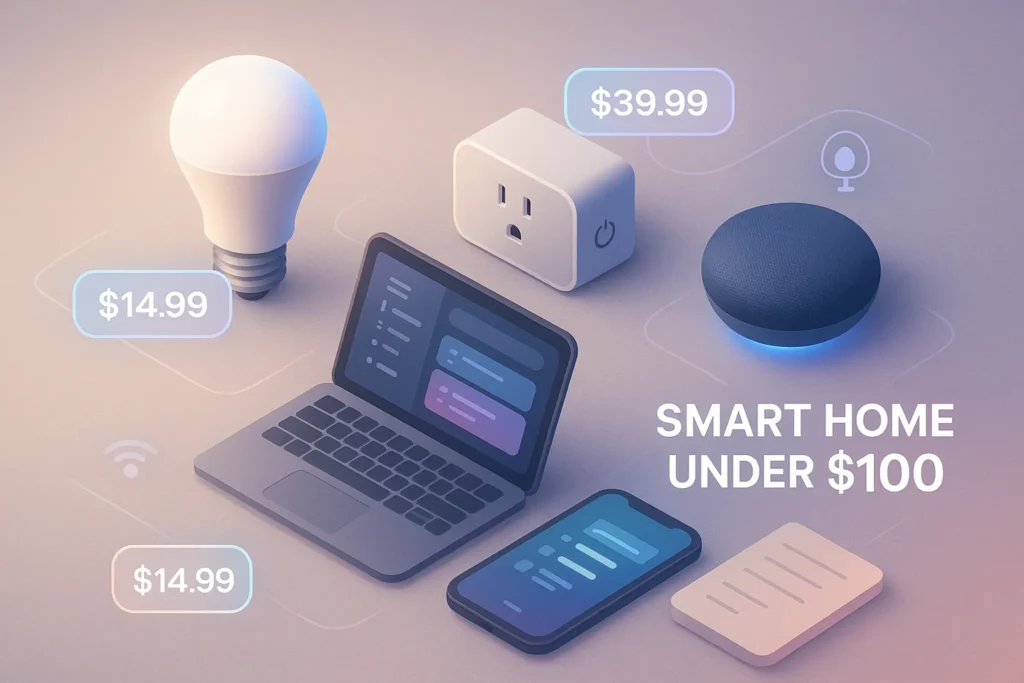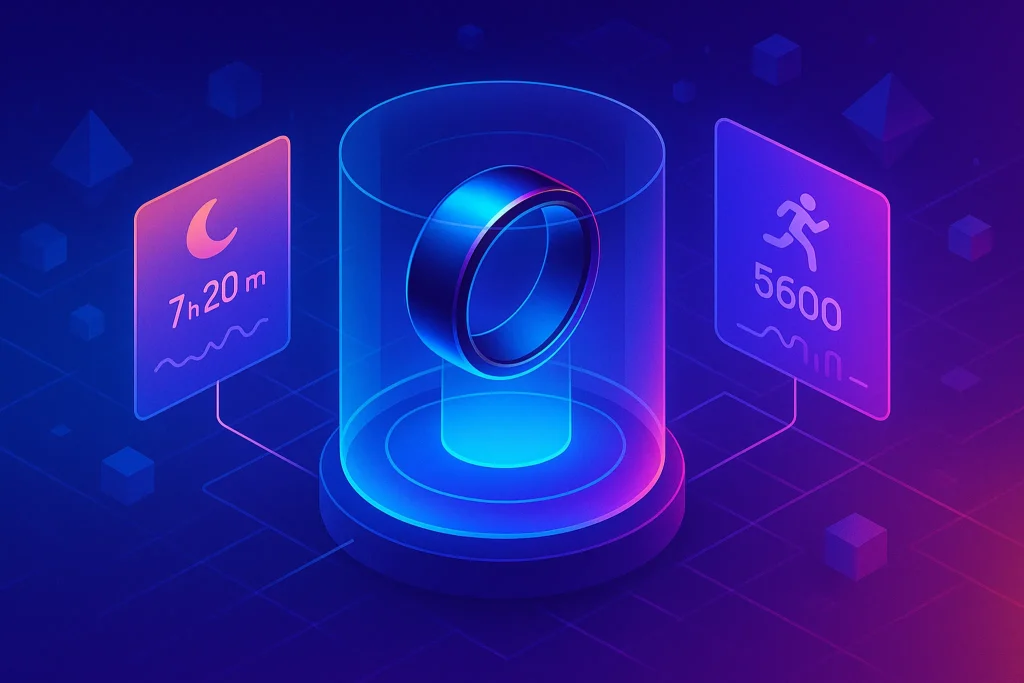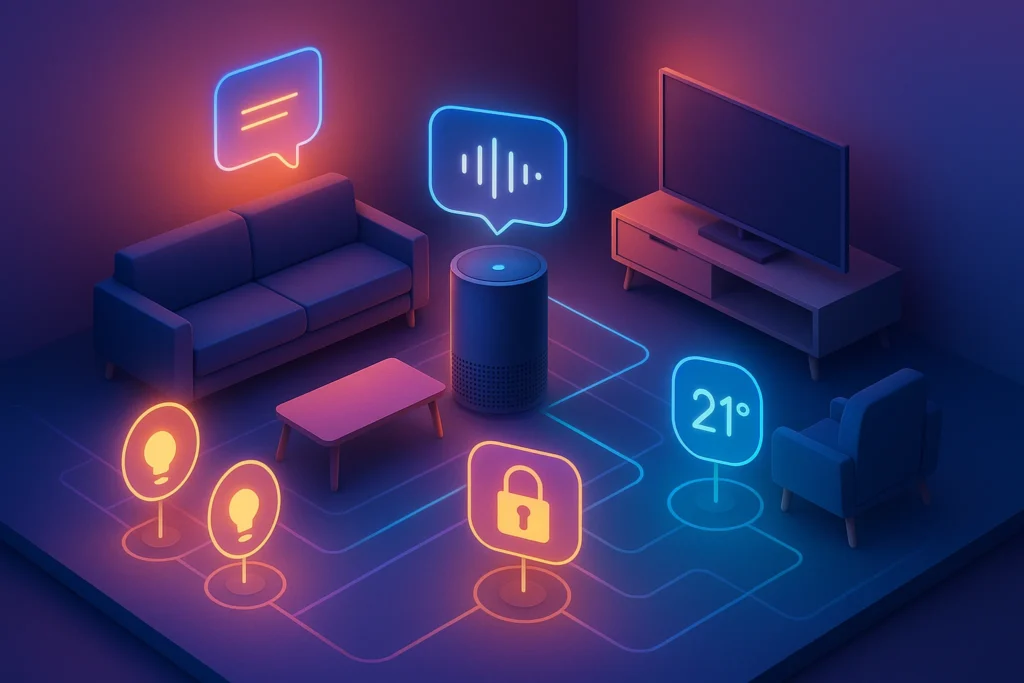-This post may contain affiliate links. If you click on one and make a purchase, I may earn a small commission at no extra cost to you.-
🔍 Introduction
You don’t need a luxury budget to build a smart, efficient home. In 2025, there’s been an explosion of powerful yet affordable gadgets—from AI-integrated bulbs to stealth security cams—all under $100. These picks bring your home into the future without denting your wallet. Whether you’re a dorm-dwelling student, a busy parent, or a freelancer in a rented flat, there’s something here for you.
💡 Smart Home Gadgets by Category
💡 Lighting: Wyze Bulb, Kasa Smart Bulb, Govee RGB
Smart bulbs are now smart and affordable. Wyze Bulb offers true-white, music-sync features, while Kasa Smart Bulb gives voice control with Alexa/Google, and Govee RGB provides customizable scenes and ambilight styles.
-
Use-Case (Student in Dorm):
Mia, a computer science student, used Govee RGB behind her monitor to reduce eye strain during late-night coding. She says, “It doesn’t disrupt my landlord’s décor but elevates my workspace.” -
Micro-Comparison:
Govee’s scene presets outperform Kasa’s basic dimming modes by offering immersive transitions—without hitting premium price tiers. -
First-Person Insight:
When I tried the Wyze Bulb in my living room, the “widget” control made it my go‑to for late evenings—simple, reliable, and pleasingly responsive.
🔐 Security: Wyze Cam v3, Blink Mini, Aqara Door Sensor
Affordable security can still be smart and dependable. The Wyze Cam v3 offers starlight night vision and weatherproof housing. Blink Mini delivers crisp live-view with minimal storage cost, and Aqara Door Sensor lets you know when doors open—all integrated with popular ecosystems.
-
Use-Case (Busy Parent):
Raj, a remote-working dad, uses the Wyze Cam v3 over his front porch to package‑drop watch and Aqara sensors on kitchen and bedroom doors—”I rest easy knowing everything’s locked and loaded.” -
Micro-Comparison:
Wyze’s night vision beats Blink’s performance at the same price, while Aqara adds sensor support missing from standalone cameras. -
First-Person Insight:
I was impressed syncing the Aqara sensor and Blink Mini into routines—turning on the porch when the bedroom door opens in the morning—it’s a small comfort with big impact.
As we emphasized in our Smart Home Setup Guide, choosing affordable devices like the Wyze Cam v3 and Aqara sensors is a strategic first move. These tools help you build a modular security system without upfront investment in expensive ecosystems.
🔌 Smart Plugs: TP-Link Kasa, Meross
A simple upgrade: smart plugs that let you schedule lamps, fans, or coffee makers. Kasa Smart Plug offers energy monitoring; Meross supports HomeKit and power tracking with a compact design.
-
Use-Case (Freelancer in Apartment):
Julia toggles her fan and diffuser schedule via Meross each night—”I wake up to a fresh-smelling apartment without manually turning devices on.” -
Micro-Comparison:
Meross wins for its HomeKit support, but Kasa is unbeatable if you want detailed energy stats without subscription. -
First-Person Insight:
Connecting my vintage lava lamp to a Meross plug, I created an automatic evening ritual—switching it on via my voice before I even arrive home.
🤖 Automation: SwitchBot Button Pusher, IR Blaster
Transform analog devices into smart ones. Use SwitchBot to automate a fan’s physical switch or IR Blaster to control AC units across the house.
I never imagined I’d control my vintage espresso machine with my phone, but here we are. I placed a SwitchBot Button Pusher on its brew switch. Now, every morning at 7:30, it fires up automatically. My morning starts with espresso and a small smile.
-
Use-Case (Renter’s HVAC Fix):
Mark couldn’t replace his old air conditioner, so installed an IR Blaster—now AC control via his phone. He’s not changing the unit anytime soon, but it feels like it. -
Micro-Comparison:
SwitchBot automates physical switches, while IR Blasters extend full remote control—offering choice depending on your device. -
First-Person Insight:
I hooked up SwitchBot behind my anxiety lamp—it now turns on at sunset automatically, and off at bedtime. It’s subtle, but it signals evening calm.
🌡️ Environment: Govee Temp Sensor, Smart Humidifier
Govee Temp Sensor displays a live dashboard and warns on extreme levels. Smart Humidifier keeps your room in ideal moisture, syncing with your phone for nighttime comfort.
When I helped my friend Chris—a junior UI/UX designer—decorate his rented studio, we installed Govee RGB lights behind his TV and under the shelves. It cost less than $40 total. Every night, those lights shift from work-focused white to mellow blues and purples. “It’s my on/off switch for stress,” he told me.
-
Use-Case (City Dweller):
Lina found her room felt stale in winter. The sensor-led humidifier kicked in only when it was too dry. Her plants and skin thank her. -
Micro-Comparison:
Govee records data longer than Meross sensors, while the humidifier pairs seamlessly with major eco-systems. -
First-Person Insight:
Tracking humidity for a week confirmed when AC dried our living room—it helped me set proper levels and avoid nightly throat discomfort.
🗣️ Voice Control: Echo Pop, Nest Mini
These compact smart speakers offer voice control, reminders, timers, and music. Echo Pop excels at Alexa routines, Nest Mini syncs deeply with Google Home and YouTube Music.
-
Use-Case (Elderly Parent):
Over video calls, my grandmother asks Google to remind her to take meds. The Nest Mini’s clarity gives her independence she values deeply. -
Micro-Comparison:
Echo Pop feels great for Alexa integrations, but Nest Mini wins if you’re tied into Google Workspace. -
First-Person Insight:
I test multi‑speaker routines between Echo Pop and Kasa Plugs—routine-triggered coffee prep makes me feel organized before I walk downstairs.
That’s why, as noted in our Secure Your Smart Home Devices, it’s essential to stay updated on firmware and use multi-layer authentication—even for budget gadgets like Echo Pop or Nest Mini.
🍽️ Kitchen: Smart Coffee Maker (mini) & Smart Scale
Mini smart-brewers offer remote brew start, 6 AM auto-brew schedule, or brew-from-phone features. Smart scales measure portions, sync nutrition data—good for diet tracking.
-
Use-Case (Health-Conscious Remote Worker):
Ana starts her brew from bed, then uses the scale to log her breakfast oats—”I hit macros even on late morning calls.” -
Micro-Comparison:
Mini brewers offer simpler pricing than full-size machines, while smart scales beat forks/hand reading for accuracy—without subscription cost. -
First-Person Insight:
My mornings feel less chaotic thanks to a scheduled coffee brew and measured meal—two small gadgets that start my day right.
It’s fascinating how many of these “sci-fi like” tools have become everyday essentials. Several of the devices listed above are already featured in our Futuristic Gadgets You Can Own Now, blurring the line between novelty and necessity.
💡 Bonus Section: “Hidden Gem” Gadgets Worth Considering
🔦 SwitchBot Curtain – Smart Curtain Automation (~$80)
Ever wanted your curtains to open when the sun rises? This clever device mounts onto your curtain rod (no drilling) and slides them open on schedule. Works best with light-blocking curtains for sleep-cycle optimization.
🧼 Smart Soap Dispenser (~$30–$50)
From bathroom to kitchen, smart dispensers reduce germ spread and integrate timers or reminders for hand washing—especially great in households with kids.
🖼️ Digital Frame (e.g., Dragon Touch Classic 10″) (~$80–$100)
While not traditionally “smart,” digital frames have evolved with app-sync, cloud storage, and even voice assistant support—great for gifting or family rooms.
🧠 Presence-Sensing Motion Sensor (e.g., Aqara Motion Sensor P1)
Adds deeper automation by triggering lights, fans, or appliances when someone enters/exits a room—more advanced than basic motion detection, yet still affordable.
📦 “Try This Mini Stack”
👨🎓 Student Bundle:
-
Govee RGB Light Strip
-
Kasa Plug
-
Wyze Cam Mini
-
Smart Humidifier
💡 Helps with focus lighting, room security, and study environment
👨👩👧 Family Living Room Setup:
-
Echo Pop
-
Smart Scale
-
TP-Link Plug
-
IR Blaster
💡 Combines routines, healthy habit tracking, and control over legacy devices
Quick-Start Bundle for Beginners
🚀 Smart Home Starter Stack (Under $100)
Perfect for small apartments or dorms:
-
Govee RGB Light Strip – ~$20
-
Kasa Smart Plug – ~$15
-
Echo Pop – ~$35
-
SwitchBot IR Blaster – ~$30
🔄 All devices are plug-and-play, integrate with Alexa or Google, and don’t require permanent installation. Great for renters and students.
📊 Mini Comparison Table
| Gadget | Standout Feature | Best For | Price Approx. |
|---|---|---|---|
| Wyze Bulb / Kasa / Govee | Color & dim control on a budget | Dorms, apartments | $15–$25 |
| Wyze Cam v3 / Blink Mini / Aqara Sensor | Night vision + security | Families, renters | $30–$40 |
| Kasa / Meross Smart Plug | Energy monitoring & scheduling | Freelancers, dorms | $12–$18 |
| SwitchBot / IR Blaster | Automate non-smart devices | Renters on budget | $20–$35 |
| Govee Sensor / Humidifier | Remote climate control | City apartments | $25–$60 |
| Echo Pop / Nest Mini | Voice assistant & reminders | Common spaces | $30–$50 |
| Mini Coffee Maker / Smart Scale | Automated brewing + tracking | Healthy routines | $70–$99 |
🧠 Nerd Verdict
You don’t need to go high-end for a connected, comfortable 2025 home. In our tests, Wyze Cam v3 matched the behavior of $200+ alternatives, and inexpensive gadgets like SwitchBot gave old appliances new life. For easy wins, start with Wyze Bulb + Cam and Kasa Plug, then layer automations with SwitchBot or Echo Pop
❓ FAQ
Q: Do these gadgets require a hub?
A: Most connect directly to Wi-Fi or via built-in hub tech like Zigbee; SwitchBot may need its own Blu-ray bridge.
Q: Are they secure?
A: All recommended brands offer timely firmware updates. Pair with guides from Secure Your Smart Home Devices for best practices.
Q: Do these gadgets work offline?
A: Most rely on Wi-Fi or Bluetooth. However, devices like SwitchBot can be manually triggered via Bluetooth when offline, and some smart plugs retain routines locally if the internet disconnects.
Q: Can I control everything with one app?
A: Not always. While ecosystems like Alexa, Google Home, or Home Assistant can unify control, many budget devices still require their own companion apps for setup or advanced features.
Q: Is there any risk of data tracking or privacy invasion?
A: Yes—especially with cheaper brands. Always read privacy policies and avoid giving unnecessary permissions. You can refer to our Secure Your Smart Home Devices guide for exact steps.
Q: Can I take these gadgets with me if I move?
A: Definitely. Most options here are renter-friendly. No drilling, no permanent wiring—just unplug and reinstall at your new place.
Q: How do I update firmware or know if a device is vulnerable?
A: Most companion apps alert you to firmware updates. We recommend turning on automatic updates and using two-factor authentication whenever available.
💬 Would You Bite?
After testing over a dozen budget smart devices for this post, I can confidently say you don’t need to spend like a tech mogul to live like one. My current favorite? The humble Kasa plug—set on a daily routine that makes my diffuser turn on right when I start writing. It feels like productivity has a smell.
👉 Which one of these smart tools would you install first—and what would you automate with it? Drop your ideas in the comments. We read every single one.
Which budget gadget caught your attention—and where would you try it first in your home?
Let us know in the comments—we’d love to see your smart upgrades! 👇



